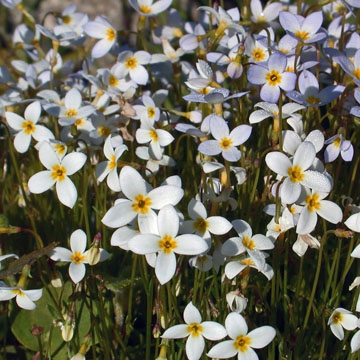

Houstonia caerulea - (image 1 of 4)
Taxonomy
Family: Rubiaceae
Habitat
Moist soil and meadows.
Associates
Distribution
Nova Scotia and Quebec to WI, south to GA and AR.
Morphology
Herbaceous perennial from slender, fragile rhizomes, eventually forming clumps to 10 cm wide, but can bloom the first year and therefore potentially annual; lower leaves opposite, oblanceolate to spatulate, 5-12 mm, narrowed to a petiole often as long; upper leaves subsessile, oblong-spatulate to linear; peduncles erect, slender, terminal and from the upper axils, 2-7 cm; flowers solitary, heterostylic; sepals narrowly oblong, 1-2 mm, acute; corolla typically light blue-lavender with a pale yellow eye, sometimes white, salverform, the tube 5-10 mm, glabrous within, the limb 10-14 mm wide; stamens included; fruit a capsule 3-4 mm wide, much broader than long; seeds globular, with a deep round cavity occupying the inner face.
Notes
Flowers April to June
Wetland indicator: FACU
Can be found at low elevations all the way up to the alpine zone in mountains. Plants at high elevation tend to have larger capsules and seeds and have been called H. faxonorum.
References
Gleason, Henry A.
and A. Cronquist. 1991. Manual of Vascular Plants of Northeastern United States
and Adjacent Canada. Second Ed.
The New York Botanical Garden. Bronx, NY
|
Michael Hough © 2018 |